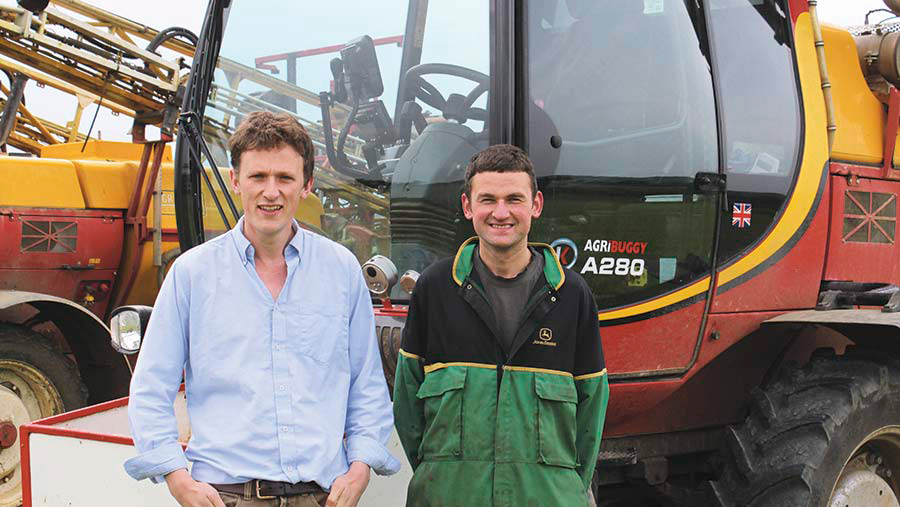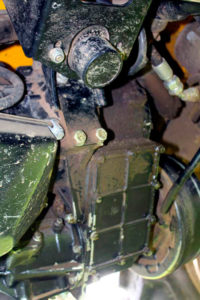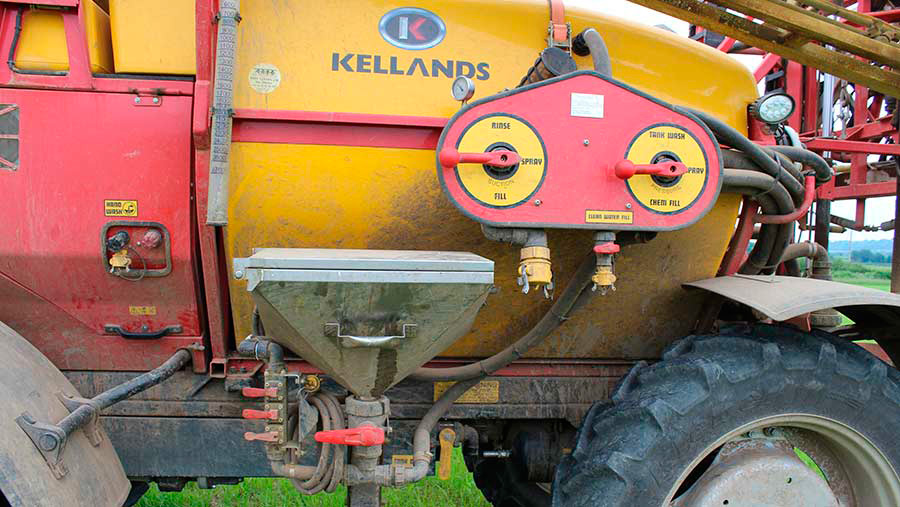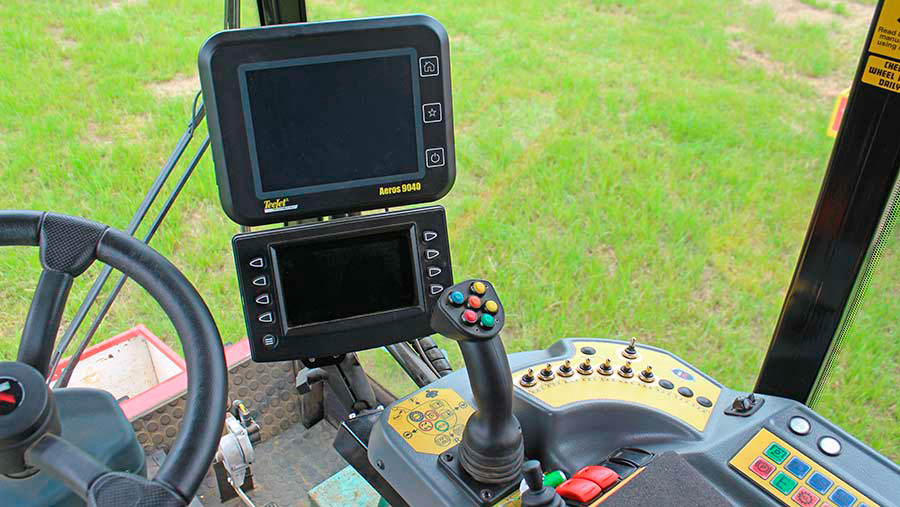Driver’s view: Kellands Agribuggy A280 self-propelled sprayer
 © RBI/James Andrews
© RBI/James Andrews In the 1970s and 1980s it seemed every man and his dog was having a stab at building a low-ground-pressure (LGP), self-propelled sprayer.
Many were little more than a crudely modified Land Rover with floatation tyres bolted on the axles, but others such as the Frazier Agribuggy were purpose-built machines that tiptoed over boggy ground like a pond skater.
See also: Farmer’s view of a Multidrive 6185 self-propelled sprayer
As farms have got bigger and tramlines have got wider, most makers of LGP sprayers have been forced to throw in the towel, or change tack.
But a few, including the Agribuggy are still going strong.
The latest machine – the A280 – now wears a Kellands badge and after a recent buyout is owned by the Alamo Group.
It has moved with the times, running booms up to 24m wide and has a 148hp Cummins block, rather than the Ford Escort-based diesels of yesteryear.
At 4.6t it’s a good bit heavier than its ancestors, but it’s still a veritable lightweight compared with a lot of hydrostatic self-propelled machines.
To find out how it performs, we visited Wiltshire agronomy and spraying contractor Boole Crop Services.

Rob Boole and driver Ben Spreadbury © RBI/James Andrews
The father-and-son team of Tony and Robert Boole have been running Agribuggies for the past 25 years and have had one of the latest A280s on the fleet for just over 12 months.
Why did you buy a A280?
A lot of our contracting work is on small, heavy, wet fields, so we have to have a compact, nimble and lightweight machine.
The Agribuggy fits the bill perfectly and the fact that Kellands is based just around the corner is an added bonus.

© RBI/James-Andrews
On top of that, the mechanical transmission is more fuel-efficient than our bigger hydrostatic machines.
Ground clearance is a slight drawback, but because so much of our work is spraying grassland and maize ground, we only ever run them on floatation and intermediate tyres.
All the high ground clearance spraying is then covered by the Househam and Bateman.
What’s it like to drive?
One of the most impressive things is how smooth and refined it is to drive.
The new cab is super quiet and it makes all the other sprayers on the fleet seem noisy. We rate the new Cummins engine, too.
This has a bit more power than the Ford fitted in the 2700 and it seems to run a bit sweeter, too.
We’re not convinced about the electronic transmission control though.
In the earlier 2700 model you’ve got an old-school, car-style shifter so you always know where you are.
Compared with that, the A280’s joystick system seems overly complicated.
Have you added any upgrades?
It came pretty well-specced as standard, but we decided to have a better quality stainless-steel induction hopper, rather than the plastic one that came as standard.

© RBI/James-Andrews
We have also modified the booms so that they’ve got clip-in sections for varying the width between 20m, 21m, and 24m.
We need this as so many of our customers are on different tramline widths – it takes about 20mins to switch width.
We also opted for the five-way rotating nozzle bodies and Teejet GPS system with autosteer.
Kellands Agribuggy A280
- Engine Cummins 2.8-litre four-cylinder
- Power 148hp
- Transmission ZF four-speed auto with two-speed transfer box and centre diff
- Transport speed 50kph
- Axles Melo with four-wheel steer
- Hours 1,000
- Tank 2,700-litre
- Booms Pommier 24m aluminium booms
- Price paid £120,000
What’s the sprayer like?
The spray pack hasn’t changed a great deal, which is a good thing as it works well.
The Pommier aluminium booms are tough, light and float pretty well.
We haven’t had any problems with cracking either, and they get plenty of stick over rough ground.
One of the big improvements over the older model is that it’s now got an electronic tank-level gauge.
This is so easy to see compared with the sight glass on the 2700 and seems to be really accurate, too.
The GPS speed sensor is also much more accurate than the old wheel-mounted one. In wet conditions we were finding our travelled area was adding up to more than our sprayed area as it didn’t account for wheel slip.
Now we’ve upgraded the 2700 so it’s running the same system as the A280.
Has it been reliable?
We’ve had Agribuggies for the past 25 years and generally they’ve been pretty reliable.
This one’s bucked the trend a bit, though.
It has only done 1,000 hours and we’ve had several transmission-related problems. It’s odd as it’s very similar to the ‘box in our 2013 2700 which has been trouble-free for 3,500 hours.
We also had some problems with the air compressor – the first one that came fitted went bang spectacularly and blew a hole in the side of the casing.
I’m glad to say after a few attempts we have a good one on there now.

© RBI/James AndrewsI
The most recent problem was a rubbed wire that caused all the electrics in the joystick to fail.
That required a whole new wiring loom.
Despite all the niggles, Kellands has been fantastic at putting everything right, and even though the last gearbox failure was outside the 12-month warranty it was replaced without any grumbles.
Would you have another?
The old 2700 should be coming up for renewal in the next year or so as it’s already on 3,500 hours.
However, the problems I’ve had with the A280 mean I might stop and think a bit before making the switch.
The thing I like about the 2700 is that it’s simple, straightforward and has a limited number of things to go wrong.
The fact that Kellands is so close and the service is so good means it is likely I’ll give it another chance, though.
There aren’t many alternative options either, other than the Alanco Spray Ranger and the Bargam from Italy.
Boole Crop Specialists’ sprayer fleet
Boole Crop Specialists is based in Lyneham, Wiltshire and sprays about 32,374ha (80,000 acres) of arable and grassland every year.
The father-and-son team of Tony and Robert Boole also provide a combined agronomy services to about 35% of their customer base.
To get round the sizable workload and deal with the massive variation in field sizes and conditions, they run a fleet of six rather different self-propelled machines:
- 2014 Househam Merlin M4-30 with 4,000-litre tank and 30m booms
- 2013 Bateman RB26 with 3,000-litre tank and 24m booms
- 2015 Kellands Agribuggy A280 with 2,700-litre tank and 24m booms
- 2013 Kellands Agribuggy 2700 with 2,700-litre tank and 24m booms
- 1999 Frazier Agribuggy Phantom with 2,000-litre tank and 24m booms
- 1996 Frazier Agribuggy 4d fitted with Avadex applicator

